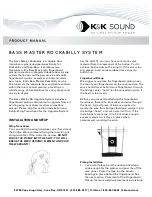
2
AGTRON MODEL E20CP-III COFFEE ROAST ANALYZER
OPERATION MANUAL
Version IR128-S5.0 & IR128-S5.5 USB/ADT
July 01/2018
INTRODUCTION
Since the earliest days of roasting, it has been common practice to determine roast development by appearance
alone- specifically the lightness or darkness of the coffee’s color in both whole bean and ground form. Using
color to classify roast introduces an inaccuracy, as the color developed during roasting is somewhat loosely
related to the organic chemistry. Organic chemistry is the source of all volatiles that produce the aromas and
flavors of coffee. Simply stated, it is possible to have two coffee samples roasted to exactly the same color /
appearance that present with quite different roast development in the cup.
AGTRON ROAST ANALYZER THEORY OF OPERATION
The most accurate method for classifying roast development is an analysis of the associated organic chemistry.
However, roasted coffee contains over 860 constituents, making comprehensive chemical analysis not only
expensive but also very difficult to unravel. The most practical alternative is the selective chemical analysis
using abridged spectroscopy.
An accurate correlation with roast development, as it correlates to the organoleptic and olfactory character of the
cup, can be established by identifying specific compounds, such as quinones, which progress during the roasting
process in a linear manner relative to the development of the collective organic chemistry.
The Agtron model E20CP-III evaluates changes to these selected compounds by measuring their photometric
response to specific wavelengths of near-infrared energy. The changes are directly linked to the collective
organic chemistry and thus to volatiles associated with cup aromatics and flavor. Results are posted as a numeric
score from 0.0 to 100.0; the lower the score, the darker the roast.
The span and slope of the Agtron Gourmet Roast Classification Scale is based on two points of reference:
1) A sample with a Gourmet Scale score of 01.2 indicates the thermal reduction of nearly 100% of the organic
chemistry into carbon, which would be devoid of coffee aromatics and flavors.
2) A sample with a Gourmet Scale score of approximately 126.0 would produce a beverage with sufficient
characteristics to be associated with roasted coffee and can be considered a sensory ‘break-point’ where
quintessential coffee aromas and flavors are beginning to be present.
3) The majority of the worlds’ coffees are roasted between Gourmet Scale scores of 30 and 75, with commercial
coffees roasted to scores between 50 and 75, and specialty coffees between 30 and 65.
CONCLUSION
The E20CP-III evaluates the manner in which selected compounds in roasted coffee change relating to beverage
olfactory and organoleptic development. This method of analysis is insensitive to color anomalies and provides
an accurate classification of roast development for quality control and consistency related to sensory assessment.
Содержание E20CP-III
Страница 25: ...25 XV CE CERTIFICATE DECLARATION of CONFORMITY...



































